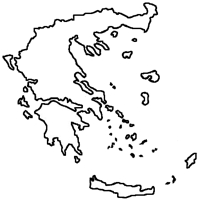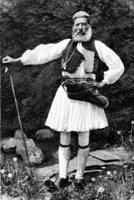
|
The Society of Folk Dance Historians (SFDH)
Greek Costume
[
Home |
About |
Encyclopedia | CLICK AN IMAGE TO ENLARGE |

|
 Until the twentieth century, the Greeks wore clothing indigenous to their customs and traditions. Its significance was in the "lore" which existed, and clothing was not only viewed from the utilitarian conception, but also from the aesthetic viewpoint. There is considerable variety, with many original types of costumes. Each place, region, island, and even village have their own distinctive costume, particularly the women's dress.
Until the twentieth century, the Greeks wore clothing indigenous to their customs and traditions. Its significance was in the "lore" which existed, and clothing was not only viewed from the utilitarian conception, but also from the aesthetic viewpoint. There is considerable variety, with many original types of costumes. Each place, region, island, and even village have their own distinctive costume, particularly the women's dress.
Greek apparel may be divided into four categories; lowland, mountain, urban, and island. the garb for men, which became national by the 19th century and which was identified with the revolution of 1821, with various local variations, was the "fustanella" (full pleated skirt) and "kapa" (hooked cloak) on the mainland, and the "vraka" (baggy breeches) on the islands. The variety and wealth of costumes for women differ with the seasons, and between the everyday, festive, and bridal gowns. The festive and the bridal dress is somewhat similar, the bridal dress being more elaborate, with accessories and jewelry showing the wealth and social class of the bride's family, and often including the dowry in gold coins added as a necklace, or on the headdress. There are also differences in the costume of the maiden, the new bride, the matron, the woman whose husband is overseas, and the widow.
The social distinction in dress came about in Byzantium and was adopted by the Greek Orthodox Church. The Patriarch of Byzantium at Constantinople (İstanbul) set down the categories of the costuming and dowry according to social class.
The Greek costumes were inspired by the fitness of the occasion, and were directly concerned with the mode of life, the occupation, as well as symbolism and artistic connection. The classical "chiton" (tunic) and "himation" (outer garment) became the wide-sleeved tunic of Byzantium, and evolved into the shirt we see today. The "yileki" (vest) and "fermeli" (sleeveless coat) are worn with the fustanella. The "selahi" (leather belt) is worn as a belt and has in it pockets where the "klephts" (brigands) stored their arms.
Some of the names of dress are:
- "enteri" – cassok (ankle-length tunic)
- "sackos" – sleeved shirt
- "kavadion" – long under tunic
- "epimanikia" – gauntlets (long gloves or cuffs).
 On the islands, there are signs of western influence from the reign of the Franks and the Venetians, as well as the Crusaders who settled here and there enroute to the religious wars. In other areas, there are oriental influences stemming from Byzantium, but in Macedonia headdresses still bear great resemblance to the ancient helmets. It is said that Alexander the Great confiscated the helmets of the cowardly men and offered them to the women who showed bravery in battle. Many of the woven brocades, golden thread, striped silks and pure silks, merino wools and heavy woolens, and deep velvets were introduced by craftsmen of the medieval guilds in Byzantium and Chios, which was then living in great splendor, a strong merchant sea power.
On the islands, there are signs of western influence from the reign of the Franks and the Venetians, as well as the Crusaders who settled here and there enroute to the religious wars. In other areas, there are oriental influences stemming from Byzantium, but in Macedonia headdresses still bear great resemblance to the ancient helmets. It is said that Alexander the Great confiscated the helmets of the cowardly men and offered them to the women who showed bravery in battle. Many of the woven brocades, golden thread, striped silks and pure silks, merino wools and heavy woolens, and deep velvets were introduced by craftsmen of the medieval guilds in Byzantium and Chios, which was then living in great splendor, a strong merchant sea power.
During the 14th, 15th, 16th, and 17th centuries, the islands of Greece particularly were merchant sea powers in the Mediterranean, and some of the ocean-going schooners were being built in the little town of Galaxidi, across Delphi toward the Peloponnese, which now is a ghost town. As a result of travels to Russia,, Odessa Italy, France, and England, new materials were introduced.
During the Turkish occupation in Yiannina, Epirus became a center of the Balkans, and shops were established there in which fine craftsmen executed special garments to order. With the War of Independence in 1821, the effect and importance of the costume began to lose it's significance, until King Othon and Queen Amalia restored the fustanella to the court and the Athenian styles from the folk costumes into what is known today as the Amalia costume. All the court ladies were required to wear the costume of their birthplaces.
Today, Greek costume survives only amongst a few old timers, and on very special occasions, or when there are special holidays when a lot of young people wear them, not as a way of life but as a memory in honor of their forefathers.
Some of the costumes remaining in families have become "heirlooms" and are passed on, as some of the older people save them for their last journey at their deaths. And thus a tradition so rich and beautiful, so closely related to man's life, has given way to the utilitarianism of the 20th century, which is putting us into the suits of conformity.
DOCUMENTS
- Athan Karras, an article.
- Greece, a country.
Reprinted from "Greek Costume" by Athan Karras
Viltis Magazine, May 1961, Volume XX, V. F. Beliajus, Editor.
This page © 2018 by Ron Houston.
Please do not copy any part of this page without including this copyright notice.
Please do not copy small portions out of context.
Please do not copy large portions without permission from Ron Houston.